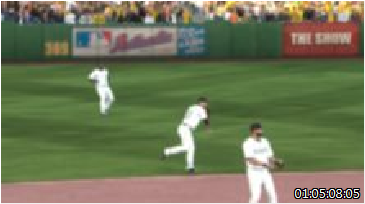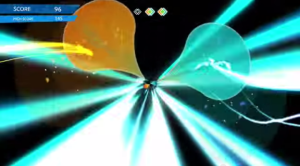2 of these 4 Xbox games don’t cause seizures!
Posted: 12/04/2014 Filed under: Results of safety testing | Tags: computer games, flash, flicker, Nintendo, photosensitive epilepsy, Playstation, seizures, Sony, video games Leave a comment
First-person shooter game Halo: The Master Chief Collection was one of the recommended Xbox titles with a higher seizure risk.
Half of the Xbox-exclusive games selected by GamesBeat for its 2014 holiday gaming guide appear to be free of seizure-provoking visuals. There were just 4 Xbox games in the buying guide, so we’re talking about exactly 2 games that meet seizure safety guidelines. I don’t know how representative this sample is of the universe of Xbox-exclusive titles.
Disney Fantasia: Music Evolved isn’t a game in the conventional sense; it’s a rhythm game played by the motion of the player’s arms, enabled by the motion-sensing Kinect controller. There are no battle scenes that might set off visually risky explosions, or races with crashes and fast-moving scenery. Instead, when players “conduct” to the beat of music selections, all sorts of colored patterns are created and set in motion on the screen. It’s visually interesting yet not overstimulating. There’s a lot of black space separating the smaller colorful elements.

Sunset Overdrive, released by Microsoft Studios, is a third-person shooter game, a relatively low risk genre, seizure-wise. Because these games tell a story from the perspective of an observer of the action, scenes are shown from a wide angle. This means that, unlike first-person shooters, any bright, explosive flashes and rapidly swirling debris don’t dominate the field of view. The larger the screen area of patterns flashing images, the higher the likelihood is that those visual effects might provoke a seizure.
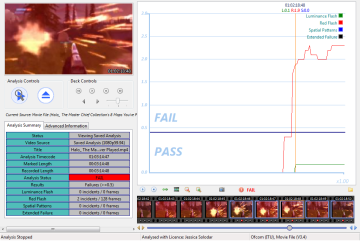
The Halo image at the start of this post is shown here in the upper left of a screen from the seizure safety testing application. The image occurs in a stretch of gunfire with flash levels exceeding seizure safety guidelines, as shown by the red line on the graph.
So it’s not surprising that first-person shooter Halo: The Master Chief Collection contains seizure-provoking images. Its predecessor Halo 4, which I tested 2 years ago along with other FPS games, failed the flash and pattern analyzer test, too.
Not so surprising, either, that the racing game Forza Horizon 2 violated seizure safety guidelines. As I’ve previously found, the quick cuts, fast-moving scenery, and dramatic collisions featured in the racing genre result in games that exceed or approach seizure safety guidelines. The original version of the game, which I tested nearly a year ago, contained a lot of scenes that flirted with safety guidelines limits, but I didn’t find actual violations.
Summing up GamesBeat’s 2014 holiday gift guide
This completes my seizure risk assessment of games chosen for GamesBeat’s 2014 holiday gift guide. In recent posts I’ve reported on the risk of seizures in the guide’s recommended multiplatform games and games exclusive to Nintendo, Sony, and PCs. After testing all 43 games in the GamesBeat 2014 holiday guide, it appears that 26 titles–60 percent–contain image sequences capable of provoking seizures.

Just 40 percent of games recommended in the GamesBeat holiday guide complied with seizure safety guidelines.
These are supposed to be the industry’s best games–how often is higher seizure risk is associated with the worst games? Or the not-especially-noteworthy? If I had unlimited time and testing resources, we could find out. Consumers deserve to see reviewers rate games for seizure risk, not just for graphics quality, speed/performance, modes of play, characters’ personalities, levels of difficulty, modes of play, frame rate, music, and so on.
Disclaimers
Please remember that your results could vary. Games that pass the seizure guidelines test could have seizure-provoking sequences that I was unable to locate. I don’t do this testing while actually playing these video games and I don’t see all the scenes. Instead I work with video clips available online, some of which are official marketing and gameplay trailers and cutscenes; others are gameplay sessions posted by reviewers or fans. I do not test fans’ gameplay clips if the original game was modified with other software.
In addition, the seizure threshold of individuals is affected by a number of factors including illness, hunger, stress, fatigue, length of play, and menstrual cycle, among others. So a game that seems OK may subsequently trigger a seizure under different conditions.
Testing methodology
I run downloaded gameplay clips, cinematic clips, and promotional trailers for each game and submit the sequences to the Harding Flash and Pattern Analyzer. The FPA is widely used by producers and networks in the UK—including by the BBC—to protect most (97 percent) but not all people with photosensitive epilepsy viewing broadcast TV. It examines video sequences for very specific and measurable image qualities that researchers have found can trigger seizures:
- rapidly alternating light and dark images (flash/flicker)
- certain stripes and geometric patterns with high contrast
- large areas of very bright (“saturated”) red
- problem images take up more than one fourth of the screen
If the first clip I test of a game fails the safety test, I move on to test the next game. I typically test at least 4 or 5 additional clips of a game if no violations are found initially. If I have a high level of suspicion due to the game genre and/or overall look of the sequences that there might be unsafe “footage” that I haven’t yet found, I may test a lot more clips.
More top 2014 Sony-only games: 5 of 8 unsafe
Posted: 10/14/2014 Filed under: Results of safety testing | Tags: computer games, flash, flicker, photosensitive epilepsy, Playstation, seizures, Sony, the last of us, video games Leave a commentHere’s another batch of exclusive-to-Sony game titles that I tested for seizure safety. These eight games were chosen by Inside Gaming Daily as the year’s best Playstation-only games. Of the eight, five contain images that could provoke seizures in viewers or players.
The test results:

Inside Gaming Daily chose these as the year’s best Playstation 4 2014 titles.
An example of totally unnecessary seizure-provoking material
Scenes of the playing field and the stands in MLB 14: The Show don’t contain seizure-provoking sequences. But the alternating blue and red stars that occasionally scroll across the screen, between plays, for a fraction of a second are a problem. They create enough flash effect and saturated red to provoke seizures. The game could be seizure-safe game just by omitting these graphics sequences.

But these fast-moving graphics sequences that appear between plays are not in compliance with safety guidelines for preventing visually-induced seizures.

…the alternating colors create a flash effect and include a large screen area of saturated red. This sequence, which appears periodically throughout the game, fails the seizure safety test on both counts.
Testing Methodology
To test the games I submit downloaded gameplay clips and promotional trailers to the Harding Flash and Pattern Analyzer. The FPA is widely used by producers and networks in the UK—including by the BBC—to ensure seizure safety of all material on broadcast TV. It examines video sequences for very specific and measurable image qualities that researchers have found can trigger seizures:
- rapidly alternating light and dark images (flash/flicker)
- certain stripes and geometric patterns with high contrast
- large areas of very bright (“saturated”) red
- problem images take up more than one fourth of the screen
Sequences submitted for analysis are video clips available online, some of which are official marketing and gameplay trailers; others are gameplay sessions posted by reviewers or fans. I do not test fans’ sequences from games that were modified with other software.
I typically test at least 4 or 5 clips of a game if no safety violations are found in the first clip. If I have a high level of suspicion due to the game genre and/or overall look of the sequences that there might be unsafe “footage” that I haven’t yet found, I may test a lot more clips. Then there are games like Entwined–as soon as I started viewing the first clip, I strongly suspected there would be seizure-provoking sequences.
Disclaimer
Your results could vary. Games I’ve listed as safe could have seizure-provoking sequences that I was unable to locate. Furthermore, the seizure threshold of individuals is affected by a number of factors including illness, hunger, stress, fatigue, and the player’s menstrual cycle, among others. So a game that seems OK the first time it’s played may trigger a seizure under different conditions.
Sony’s top 2014 games: 5 of 9 test as unsafe
Posted: 10/08/2014 Filed under: Results of safety testing | Tags: computer games, flash, flicker, photosensitive epilepsy, Playstation, seizures, Sony, video games Leave a comment
Games (and films) in animé art style typically contain many instances of unsafe image sequences. This screen shot is from Fairy Fencer F.
Roughly half of the year’s most eagerly anticipated made-for-Sony video games could set off a seizure. I tested the seizure safety of the nine Sony-only titles selected last month by GamesBeat for its “early holiday gaming guide.” Five games failed the safety test, indicating that their graphics exceed safety guidelines for flash, intense color, and/or patterns known to trigger seizures.
Watch out for animé graphics
In this selection of games exclusive to Sony platforms, those made for the PS3 were more likely to trigger seizures than those for the PS4 or Vita–probably because the PS3 games in this batch of titles were overwhelmingly illustrated in animé style graphics. Animé is the animation style used in the infamous Pokémon cartoon incident in Japan, when hundreds of Japanese children viewing the cartoon experienced seizure symptoms simultaneously and went to emergency rooms.
Here are the results for the nine Sony games:

Testing methodology
I run downloaded gameplay clips and promotional trailers for each game and submitted the sequences to the Harding Flash and Pattern Analyzer. The FPA is widely used by producers and networks in the UK—including by the BBC—to ensure seizure safety of all material on broadcast TV. It examines video sequences for very specific and measurable image qualities that researchers have found can trigger seizures:
- rapidly alternating light and dark images (flash/flicker)
- certain stripes and geometric patterns with high contrast
- large areas of very bright (“saturated”) red
- problem images take up more than one fourth of the screen
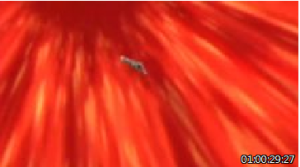
This completely red screen from a sequence in Fairy Fencer F failed the safety test due to excessive saturated red color.
Sequences submitted for analysis are video clips available online, some of which are official marketing and gameplay trailers; others are gameplay sessions posted by reviewers or fans. I do not test fans’ sequences from games that were modified with other software.
If the first clip I test of a game fails the safety test, I note that and move on to test the next game. I typically test at least 4 or 5 additional clips of a game if no safety violations are found initially. If I have a high level of suspicion due to the game genre and/or overall look of the sequences that there might be unsafe “footage” that I haven’t yet found, I may test a lot more clips. For example, knowing that the fast-moving views in racing games may be seizure-inducing, I tested more than a dozen Driveclub clips.
Similarly, the art style and pace in other games look highly unlikely to pose a seizure risk–I tested only a couple of clips from LittleBigPlanet 3.
Disclaimer
Your results could vary. Games I’ve listed as safe could have seizure-provoking sequences that I was unable to locate. Furthermore, the seizure threshold of individuals is affected by a number of factors including illness, hunger, stress, fatigue, and the player’s menstrual cycle, among others. So a game that seems OK the first time it’s played may trigger a seizure under different conditions.
I’ve already tested what GamesBeat editors consider the year’s biggest games for multiple platforms. In upcoming posts I’ll share test results on their choices for PC-based games and for games exclusively built for Nintendo and Microsoft gaming platforms.
Lawsuits filed after games caused seizures
Posted: 04/06/2013 Filed under: Legal Action, Seizure Warnings, Video Game Companies | Tags: American Academy of Pediatrics, computer games, Nintendo, photosensitive epilepsy, photosensitivity, product liability, seizure warning, Sony, Ubisoft, video games 3 Comments No consumer has won a product liability/personal injury case against a game manufacturer whose video game triggered seizures. Cases were either dismissed, settled, or won by the game company.
No consumer has won a product liability/personal injury case against a game manufacturer whose video game triggered seizures. Cases were either dismissed, settled, or won by the game company.
Despite their limited usefulness to consumers, seizure warning notices do seem to provide legal protection to game publishers. And juries have a hard time awarding damages to plaintiffs with a pre-existing condition, even if plaintiffs didn’t know of their photosensitive epilepsy prior to the seizure(s) triggered by a video game.
In one case Nintendo actually conceded that its game had in fact triggered seizures, but that didn’t get in the way of the company winning the case. A judge later overturned the jury’s verdict because Nintendo had withheld critical information in contempt of court.
The cases date back to 1991, but the apparent total number of cases–ten–is pretty small. One has to wonder what percentage of the seizures triggered by exposure to video games are ever identified as visually induced seizures.
One of the few consumers to reach a settlement is John Ledford of Alabama, whose settlement agreement bars John from discussing his own case. John has found another way to raise awareness of video game seizures. He has researched other cases and reached out to epilepsy organizations around the globe to raise their awareness of the continuing seizure hazard from video game images. John’s Facebook page contains most of the history I’ve assembled here:
| Year Filed | State | Plaintiff(s) | Game(s)/Platform/Defendant | Outcome |
| 1991 | MI | 15-year old Laura Moceri had grand mal seizure while playing. | Kid Icarus (Nintendo) | Lost |
| 1993 | IL | Chicago boy suffered occasional seizures during many hours of game play. | Nintendo | Dismissed |
| 1995 | AL | John Ledford had his first ever grand mal seizure while playing game at an arcade. The seizure damaged his optic nerve and caused blindness in one eye. | King of the Monsters II (SNK Corp.) | Settled |
| 1998 | LA | 13 year-old Joey Roccaforte had clusters of violent seizures | Mega Man X (Super Nintendo) | Jury ruled for Nintendo; judge later vacated the decision because Nintendo withheld critical information before and during trial. |
| 2001 | LA | Esther Walker, mother of 30-year old Benjamin Walker, who died from hitting his head on a table and sustaining internal injuries during a game-induced seizure. | Nintendo 64 | Lost |
| 2001 | LA | 11 year-old Michael Martin, son of Eric Martin, mayor of St. Martinsville, LA. Seizures that began happening during games began occurring also during sleep. | Super Mario Kart (Nintendo 64) | Settled personal injury claim; lost case advocating better warnings. |
| 2001 | LA | 6 year –old Kynan Hebert, son of Lynette Benoit | Nintendo | Dismissed |
| 2002 | FL | 16 year-old Dominic Zummo | Star Wars Episode I: Jedi Power Battles (LucasArts Entertainment, SONY) | Unknown |
| 2007 | NY | While watching his brother play a game, 4 year-old boy had a seizure causing permanent injury. | Spyro: Enter the Dragonfly (Vivendi, SONY Playstation 2) | Last available information: attorney for plaintiff was seeking other plaintiffs for class action suit |
| 2011 | CA | Navy F-18 pilot John Ryan McLaughlin injured in a grand mal seizure that causes permanent loss of flight status | Oblivion: The Elder Scrolls IV (Bethesda Software), Sony Playstation 3. | Still pending; no other information available. |
What constitutes product liability?
In 1997 the criteria for product manufacturer’s liability for a product that has caused harm were revised by the American Law Institute, an independent body of legal experts that drafts and publishes restatements of common law in order to clarify and simplify it. Its work is used as a resource by state lawmakers, judges, and lawyers. Every state has its own laws concerning burden of proof, the awarding of damages, and the like.
The 1997 restatement of product liability law states, “a product is defective when, at the time of sale or distribution, it contains a manufacturing defect, is defective in design or is defective because of inadequate instructions or warnings.” These conditions are then defined separately:
- A product “contains a manufacturing defect when the product departs from its intended design even though all possible care was exercised in the preparation and marketing of the product.”
- A product “contains a design defect when the foreseeable risks of harm posed by the product could have been reduced or avoided by the adoption of a reasonable alternative design by the seller or other distributor, or a predecessor in the commercial chain of distribution, and the omission of the reasonable alternative design renders the product not reasonably safe.”
- A product “is defective because of inadequate instructions or warnings when the foreseeable risks of harm posed by the product could have been reduced or avoided by the provision of reasonable instructions or warnings by the seller or other distributor, or a predecessor in the commercial chain of distribution and the omission of the instructions or warnings renders the product not reasonably safe.”
Some game companies are apparently working to make games that do not provoke seizures, but only Ubisoft has made a public commitment. As far as I can tell, most are merely reworking their warnings.
Today the sound, tomorrow the picture?
Posted: 01/20/2013 Filed under: Photosensitive Seizure Prevention, Political Action & Advocacy, TV, Video Game Companies | Tags: computer games, International Telecommunication Union, photosensitive epilepsy, photosensitivity, seizure prevention, Sony, video games 9 Comments Have you noticed that watching TV is less annoying lately? Commercials are now required to be no louder than the programming surrounding them. On December 13 an FCC regulation went into effect that was designed for just that. The CALM Act, approved by Congress in 2010, directed the Federal Communications Commission to make it possible to watch TV without constantly turning down the volume of advertisements.
Have you noticed that watching TV is less annoying lately? Commercials are now required to be no louder than the programming surrounding them. On December 13 an FCC regulation went into effect that was designed for just that. The CALM Act, approved by Congress in 2010, directed the Federal Communications Commission to make it possible to watch TV without constantly turning down the volume of advertisements.
Since the introduction of television in the 1950s, many consumers have complained to the FCC about the loudness of commercials. What prevented the FCC from doing anything in response was that the issue was technically complicated. Multiple factors can contribute to the perceived loudness of a broadcast, including the strength of the electrical signal, the degree to which the sound signal is compressed. In addition, there was no standard method for content creators and broadcasters to measure broadcast volume.
In 2006, the International Telecommunication Union–the same UN-affiliated standards body that has published specifications for protecting TV viewers from photosensitive seizures–proposed a new technique for measuring broadcast volume that allows uniform evaluation across national boundaries. In addition, the ITU proposed a numerical “target loudness” using the new loudness gauge. Thanks to the ITU, it became possible to define, comply with, and enforce limits on loudness.
Four years later the United States Congress passed the CALM Act with little debate, by unanimous vote in the Senate and by a voice vote in the House. California Congresswoman Anna Eshoo, who introduced the bill, said it was by far the most popular bill she’d ever sponsored. She said the bill “gives consumers peace of mind, because it puts them in control of the sound in their homes.” She was quoted saying, “If I’d saved 50 million children from some malady, people would not have the interest that they have in this.” By that time the UK, France, Norway, Italy, Japan, Brazil, Israel, Germany, Austria, Switzerland, Poland, and the Netherlands were already limiting the loudness of commercials or had begun action on the issue.
These days even the video game industry is paying attention to some kind of audio standards, if only for consistency across products. According to an July 2012 interview in Designing Sound, Sony Computer Entertainment Europe is looking at smoothing out the volume among their own game titles.
Unfortunately, in this country making TV safer to watch for the visually sensitive–or making video games safer to play–isn’t on the legislative agenda. Consumers and policy makers aren’t aware of the need. The technical groundwork is already in place for regulations to prevent screen-induced photosensitive seizures, thanks to ITU specifications (and similar versions developed by the UK and Japan), and to similar guidelines adopted by the World Wide Web Consortium for web-based content.
Here’s where things stand at the moment in making US electronic screens safe for those with photosensitive epilepsy: Photosensitive epilepsy protection standards now apply to all federal agency websites. The Photosensitive Epilepsy Analysis Tool (PEAT) downloadable from the PACE Center at the University of Wisconsin at Madison makes available to website designers and software developers a free tool that tests screen content for compliance with seizure safety guidelines. The tool is not intended for entertainment industry developers, however; these companies need to buy commercially available assessment tools.
I’ve written previously about some of the complexities of bringing new screen safety standards to the American telecommunications industry. I”m going to learn more about the legislative process in coming months. My State Representative filed a bill last week to create a commission to study the issue of video game safety for minors at home and in school here in Massachusetts. It will take considerable time to even bring the bill to a public hearing, but as I’ve recently learned, all bills filed in the Massachusetts legislature receive a public hearing at some point in the two-year session. The two years just began this month. Stay tuned.
PlayStation Vita games: seizure safe?
Posted: 02/22/2012 Filed under: Video Game Companies | Tags: computer games, flash, flicker, game trailers, photosensitive epilepsy, photosensitivity, PlayStation Vita, Sony Leave a comment
The logo sequence (top left) of PlayStation Blog’s “PULSE” can cause seizures, as shown by the luminance (flash) level registering in the Fail zone.
Are video games getting safer? Occasionally someone claims that game developers don’t make seizure-inducing games anymore–I have no idea what the basis is for this assumption. Today’s North American launch of the PlayStation Vita handheld platform provides an opportunity to see whether there might be any truth to such rumors. And the answer is…nah, I don’t think so.
In anticipation of today’s launch of Sony’s latest mobile gaming device, I viewed and tested gameplay sequences form trailers for 8 or 10 some Vita games available at launch time and in the near future. Although I did not find much material that failed the safety test in trailers I looked at, for several reasons I cannot state these games appear seizure safe.
- Because I’m not set up to test gameplay myself, to evaluate the seizure safety of video games, I rely on gameplay shown in the promotional trailers. From these snippets I can’t do a very thorough job of testing. I can’t tell how representative the clips are of all possible game action, and I can’t determine whether all the screen action that stays just inside the safety zone of the analyzer application would cross the line into the “failure” zone if the scene continued for another couple of seconds.
- I couldn’t accurately test most of the sequences for the Vita games because of the way the trailers were filmed. See explanation below.
- Even without testing the Vita games themselves, I found a consistent problem with logo graphics sequences in the game trailers that were unsafe. If Sony were committed to making its games seizure-safe, it’s hard to figure how the marketing people could overlook the safety of their promotional videos, no?
Promotional trailers fail the seizure test!

Flash levels in a sequence (top left) from today’s PlayStation blog–announcing the Vita’s US availability–fail seizure safety test (above)
Every couple of weeks Sony posts a new edition of its PULSE promotional blog to keep customers current on upcoming games, marketing events, and product launch updates. To learn about the Vita’s features and the games line-up, I first went to Sony’s PlayStation blog, and the moving graphic that evolves into the PULSE logo on those blog entries creates a seizure risk! It consistently failed the Harding Flash and Pattern Analyzer seizure safety assessment.
Today’s PlayStation blog entry – in all the excitement of announcing the Vita’s arrival – has, in addition, an unsafe flash sequence that’s unrelated to the logo or to the game screen.
Filming format invalidates safety algorithms
Many of the PlayStation games are available across the whole family of PlayStation devices, so it doesn’t appear that there’s much difference in their screen graphics from one device to another. So watching a trailer for a PlayStation 3 game isn’t much different than watching the trailer for a Vita game. Except for one thing.
Most of the Vita trailers are shown with the game screen action taking up less than the full screen. Instead, the filmed gameplay is shown surrounded by the thick frame of the Vita device itself. This means that when the flash and pattern analyzer software calculates the effect of the game trailer’s visual stimuli, the impact of the stimuli will be significantly reduced. In other words, when trailers are filmed with a solid screen around them, the flash and pattern analyzer cannot follow its standard algorithms to determine compliance with photosensitive seizure safety guidelines, leaving me unable to test the safety of a given game sequence.

Game trailers for the PlayStation Vita often include a view of the controls. Gameplay takes up a smaller region of the screen, invalidating calculations used by the seizure safety analyzer.
Here’s why. Advice from experts on reducing the likelihood of visually induced seizures usually begins with not getting too close to the screen. That’s because the same flash that fills a smaller segment of your field of vision may be safe for viewing, whereas closer up it could have a greater impact on the brain. Because the game screen in these trailers takes up less than the full screen, the analyzer is “fooled” into assuming there is less significance to each bright flash.
To determine the level of visual stimulation produced by various types of seizure-provoking visual sequences on video, researchers created algorithms that take into account the percentage of the screen that is involved for each visual effect. So a bright flash that occupies the full screen is “scored” differently for safety than the same flash that takes up only 75 percent of it. The impact on the brain is lessened when the stimulus occupies a smaller area. For the same reason, experts recommend keeping a distance from TV and game screens, to lessen the portion of the visual field that is affected.
Am I missing something? If Sony or anyone else would like to set me straight on this, I’m listening.
Game forums blame pilot, natch
Posted: 05/17/2011 Filed under: Legal Action, Video Game Companies | Tags: computer games, Oblivion: The Elder Scrolls, Playstation, seizures, Sony, video games Leave a comment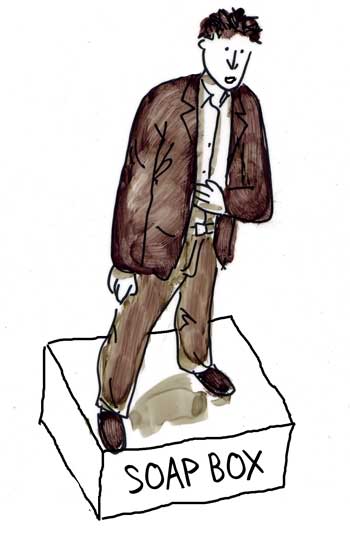 While product liability suits don’t generally get a lot of respect, litigation is often an effective way to pressure manufacturers to make their products safer for consumers. In my last post I was wondering what the game forums would have to say about the lawsuit recently filed by John Ryan McLaughlin, a former F-18 pilot who has permanently lost his flight status as a result of a seizure he experienced while playing Oblivion: The Elder Scrolls IV.
While product liability suits don’t generally get a lot of respect, litigation is often an effective way to pressure manufacturers to make their products safer for consumers. In my last post I was wondering what the game forums would have to say about the lawsuit recently filed by John Ryan McLaughlin, a former F-18 pilot who has permanently lost his flight status as a result of a seizure he experienced while playing Oblivion: The Elder Scrolls IV.
A thick skin is required just to lurk on these forums because the level of hostility can be so high when posters comment on a perceived threat to a game or game company. Some of these game forums are populated by folks paid to post comments supportive of the company/industry, but I suspect most of the people who post their disdain for those with photosensitive epilepsy are just—how should I say this—lacking in social graces and emboldened by the anonymity of the Internet. As expected, talk of McLaughlin’s legal action quickly brought out contemptuous and often ill-informed postings.
Here are a few examples of what I found in the forums, somewhat sanitized. Most are plug-and-play responses that have been trotted out already in other discussions about video games provoking seizures:
- The pilot should be grateful to the game for exposing a hidden condition he didn’t know he had. Especially since the consequences would likely be quite dire if a seizure had happened in the cockpit.
- It’s probably a coincidence that the seizure happened while he was playing.
- The poster has epilepsy and has never had a game seizure. So obviously there’s something fishy about the story.
- If the game hadn’t triggered a seizure, something else would have.
- Maybe his sensitivity to all that screen flashing developed from all the years of flying F-18s, and the video game just triggered a seizure. (This one is my personal favorite.)
Navy pilot loses flight status after video game seizure
Posted: 05/11/2011 Filed under: Diagnostic Challenges, Legal Action, Video Game Companies | Tags: Bethesda Softworks, computer games, Oblivion: The Elder Scrolls, photic stimulation, Playstation, seizures, Sony, video games 2 Comments A former Navy pilot permanently lost his flight status after experiencing a seizure while playing the game Oblivion: The Elder Scrolls IV on a Sony Playstation 3. John Ryan McLaughlin, an F-18 pilot based in San Diego, also broke a bone in the incident. McLaughlin has filed suit against the game manufacturer, Bethesda Softworks, and Zenimax Media, its corporate parent, as well as Sony. Read the story here.
A former Navy pilot permanently lost his flight status after experiencing a seizure while playing the game Oblivion: The Elder Scrolls IV on a Sony Playstation 3. John Ryan McLaughlin, an F-18 pilot based in San Diego, also broke a bone in the incident. McLaughlin has filed suit against the game manufacturer, Bethesda Softworks, and Zenimax Media, its corporate parent, as well as Sony. Read the story here.
Note that pilots are very, very carefully screened for possible seizure disorders–using photic stimulation, which really can’t replicate the visual experience of a video game. I have to wonder how the game forums will respond to this…usually these commenters love to blame the parents of children who have video game seizures, claiming everyone should have anticipated it would happen. This very sobering case involves someone highly trained to defend our country, who’s been tested up and down to detect even the hint of a seizure problem, who now can’t use his flight training anymore. Ever. Are the game forums going to blame a guy who’s been certified seizure-free for not paying attention to a warning in the game’s user manual? Or maybe find his parents responsible?
Read more about lawsuits filed by consumers who experienced seizures from video games.

